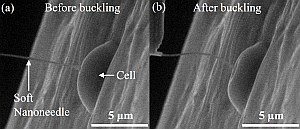The stiffness of individual cells can be measured by observing the buckling of nanometer-sized needles

Fig. 1: Scanning electron microscopy image showing local stiffness measurement on a single cell using a buckling nanoneedle.
Single-cell analysis is expected to shed light on individual cell properties and provide the means to discriminate healthy cells from unhealthy ones. With this aim in mind, a research team from the Nagoya University GCOE for Micro-Nano Mechatronics led by Mohd Ridzuan Ahmad and Toshio Fukuda1 has developed a flexible nanometer-sized silicon needle that can be used to measure the stiffness of a cell at specific points.
Although large-scale bulk mechanical measurements of organisms are relatively easy, it remains challenging to detect small variations in stiffness among single cells. Some researchers have used atomic force microscopy (AFM) cantilevers to determine the mechanical properties of living cells by forming nanometer-sized indentations on cell surfaces. However, the tapered shape of the cantilevers prevents them from reaching the cells when the samples are tightly confined or mounted on inclined surfaces. Rigid 'nanoneedles', which are sharper, meet these geometric constraints, but can puncture and damage the cells.
Using a combined computational-experimental approach, Ahmad and his team designed a flexible nanoneedle to gain control over the indentation force. To manufacture their needle, they etched a commercially available AFM tip onto a 150-200 nm-thick silicon slab using a focused beam of ions, and then produced the nanoneedle by trimming the width of the slab.
The researchers also designed an 'environmental scanning electron microscope' (ESEM) equipped with a nanorobotic system to manipulate and monitor the nanoneedle in real time during measurements. They found that the ESEM, which allows measurements to be carried out under high humidity levels, sustained greater cell viability compared with a conventional, high-vacuum SEM instrument.
The team tested the performance of their flexible nanoneedle using yeast cells. "Yeast is one of the simplest eukaryotic organisms, but many essential cellular processes are conserved between yeast and humans," says Ahmad. "They divide in a similar manner to our own cells and share many other basic biological properties."
The researchers imaged the nanoneedle as it approached and contacted the cells (Fig. 1). They showed that the needle bent upon contact to form the indentation, yet retained its straight shape when pulled back.
The team believes that the buckling nanoneedle could be used a force sensor to quickly detect significant variations in stiffness between test samples. "This capability could lead to great applications in disease diagnosis, because the buckling level of the nanoneedle will differ between healthy and unhealthy cells," says Ahmad.
The researchers are currently investigating the potential use of their nanoneedle as a diagnostic tool.
Affiliated Researchers
The Nagoya University affiliated researchers mentioned in this highlight are from the Micro-Nano Mechatronics GCOE program of the Department of Micro-Nano Systems Engineering.
Reference
- Ahmad, M. R., Nakajima, M., Kojima, S., Homma, M. & Fukuda, T. Buckling nanoneedle for characterizing single cells mechanics inside environmental SEM. IEEE Trans. Nanotech. Published online: 12 Dec 2009 | doi: 10.1109/TNANO.2009.2036997 | article